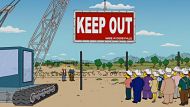What if there was a recession, and no one noticed?
It's entirely possible. We don't normally think of the 2000 Sydney Olympics as a particularly bad time, yet in the June and September quarters of that year GDP slipped 0.4 per cent. As it happened, in the first of those quarters GDP barely grew, by a rounding error of $423 million, and in the second it slid $1.1 billion.
More Videos
Economy goes backward
GDP contracted 0.5 per cent in the September quarter. The Treasurer points the finger at weak business investment.
If GDP in the June quarter had been just $424 million worse, or if in future years it is revised down by $424 million, the year of our Olympic glory would become "officially" a recession and that quarter of a century without a recession wouldn't have happened.
In fact, that's already happened. GDP numbers are being revised all the time. A few years back the Bureau of Statistics was saying the economy shrank 0.02 per cent in the September quarter of 2000 and by 0.4 per cent in the December quarter, a "technical recession" under John Howard and Peter Costello, which was then revised away again.
In the US they're nowhere near as silly. Over there, there is no such thing as a technical recession until a group of elders say so. A committee of the National Bureau of Economic Research gets together, takes wide soundings and then issues a proclamation.
As it says on its website, "The Bureau does not define a recession in terms of two consecutive quarters of decline in real gross domestic product. Rather, a recession is a significant decline in economic activity spread across the economy, lasting more than a few months, normally visible in real GDP, real income, employment, industrial production, and wholesale-retail sales."
In the past it's declared recessions ended before we would have said they ended, and declared them started after we would have been calling the recession technical.
And, just as in the Olympics year of 2000, what we've got now doesn't feel like the start of a recession and doesn't feel much like a downturn.

GDP fell by 0.5 per cent in the September quarter, leaving Scott Morrison and Malcolm Turnbull looking silly after an election campaign that promised jobs and growth. As slides go it was big, bigger than the slide of 0.2 per cent in the March quarter of 2011 when a cyclone in Queensland wrecked the banana crop. But that didn't seem that bad, unless you worked in one of the industries affected.
One of the reasons it doesn't feel that bad for many of us this time is that during the same quarter, employment (hours worked) climbed 0.5 per cent and the best measure of living standards (real net national disposable income per head) also climbed 0.5 per cent.
Living standards can climb while GDP falls because the two measure different things. GDP growth takes no account of changing export prices. Right now they are rising. Nor does it take account of interest and dividend income enjoyed by Australians earned overseas. Of late that's been rising. The truer measure, real net national disposable income, is climbing, even when it is shared among a growing population.
If the December quarter GDP is similar to the September quarter, we'll be in what some call a recession, but we needn't be worse off.
If the December quarter GDP growth is similar to the September quarter GDP growth, we'll be in what some call a technical recession, but we needn't be worse off.
Although some of us will be. Unacknowledged in the GDP figures is a shocking difference in conditions in the cities and the country. Calculations by Terry Rawnsley of SGS Economics and Planning for Fairfax Media suggest that during 2015-16, boom-time Sydney's enjoyed economic growth of 4.5 per cent and Melbourne 4.4 per cent. But the rest of NSW (including several major cities) grew by just 0.4 per cent over year while rest of Victoria shrank 1 per cent.
Even if GDP does shrink for a second consecutive quarter, the Treasury and the Reserve Bank are likely to "look through" the reported numbers to focus on what's happening beneath them. The bad news is this means there might not be further interest rate cuts to stave off recession even if the figures show we are in one. And they could.
Business investment slid enough in the September quarter to knock 0.4 per cent off GDP. There's no particular reason to think it won't slide again. The Reserve Bank believes 80 per cent of the slide in mining investment is behind us, but that still leaves a lot to come.
The downturn in construction, which knocked 0.3 per cent off GDP, might also continue, but the 0.1 per cent which was the result of sliding residential construction probably won't continue. The Bureau of Statistics reports a very big 'pipeline' of residential construction commissioned but yet to be done. If the weather is better in the December quarter, a lot of it will be.
Early indications from retailers are that October and November were good, and government investment (in helicopters and submarines and the like) is so unpredictable that anything could happen.
And mere talk of a recession could make something happen, as could the inauguration of Donald Trump. But this doesn't mean that things are necessarily bad, yet.
If we hadn't heard the news, many of us mightn't have noticed.


















117 comments
Comment are now closed